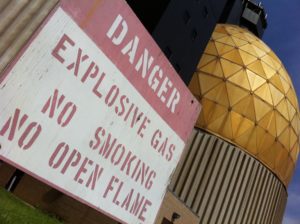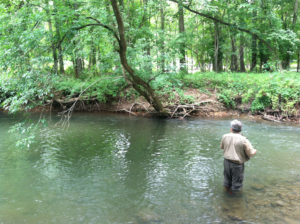Things Looking Better Overhead but Worse Below

“Air pollution in the state falls to three-decade low” trumpted a recent Washington Post article. Sub-title: “Md. set to meet federal standards, thanks to environmental efforts.” Well, Booyah, I say!
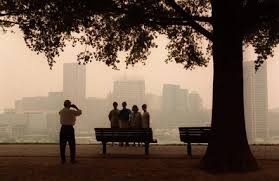
 It was a while back (August 2013) that I used this first image in a post that commented about air pollution, GHGs and allergies. It shows the Baltimore City skyline in the background. Then another image about the consequences of lousy air. But, I dreamt of much clearer skies one day.
It was a while back (August 2013) that I used this first image in a post that commented about air pollution, GHGs and allergies. It shows the Baltimore City skyline in the background. Then another image about the consequences of lousy air. But, I dreamt of much clearer skies one day.
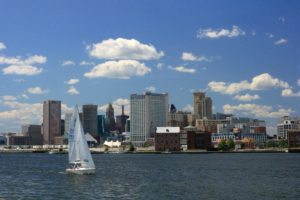 The article goes on about measurements by the U.S. EPA showing the state is now meeting its 2012 standard for fine-particle air pollutants such as soot. While not mentioned in the article, I suspect that nearby coal-fired power plants are emitting fewer noxious effluents due to better pollution controls, such as a newer generation of stack scrubbers that capture soot. Inexpensive natural gas may be another factor as coal has become comparatively more expensive, ergo less used.
The article goes on about measurements by the U.S. EPA showing the state is now meeting its 2012 standard for fine-particle air pollutants such as soot. While not mentioned in the article, I suspect that nearby coal-fired power plants are emitting fewer noxious effluents due to better pollution controls, such as a newer generation of stack scrubbers that capture soot. Inexpensive natural gas may be another factor as coal has become comparatively more expensive, ergo less used.
Fortunately for Marylanders, the state legislature has upped again the percent reduction of GHG emissions from the 2006 standard–40% below by 2030 (as I’ve reported). Upwind states such as the Commonwealth of Virginia must also do better to help Marylanders.
Aren’t we who live in urbanized areas along either coast just trying to get out of the same continuous “fog”?
♥
A couple of days ago there was a headline in the Metro section of the Washington Post declaring: “Harbor again gets failing grades in water-quality report.” If you read last week’s post here you could have figured it, right?
As mentioned in that post, I joined a bunch of others at the 3rd Annual Chesapeake Bay Foundation (CBF) meeting of Baltimore members. On one of the tables was literature from the CBF, Blue Water Baltimore and others. Among it was a postcard with pre-printed text addressed to Baltimore’s mayor. Here it is-
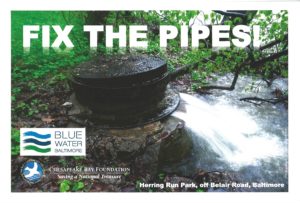
The text began: “As a resident of Baltimore, I challenge you to do more to address the city’s failing sewage system.” Message went on to say the city has had 14 years to get with the program. Attendees were encouraged to fill in the card with name/address/email, stamp and mail. Actually, the stamping and mailing were handled by the CBF if you left your filled-in card in a basket.
The Post article reported further: “The primary concerns continue to be fecal bacteria from the city’s aged and leaking sewage system and pollutants that flow into the harbor when it rains.”
Back in 2010, civic, business and environmental groups set a goal of a “swimmable, fishable harbor” within 10 years. Now, over half way through, the report by the Healthy Harbor Initiative of the Waterfront Partnership of Baltimore casts a pal over that goal.
That said, cheers arose from environmentalists when observing that the Gwynns Falls, one of the waterways leading into Baltimore’s Inner Harbor and beyond into the Chesapeake Bay, d-i-d-n-o-t-r-e-c-e-i-v-e a failing grade. It got a “D”.
At the Baltimore Back River Wastewater Treatment Plant, a $500M upgrade will, according to construction-today.com, provide: “chemical feed facilities, 52 biological filters and a 300-million-gallon-per-day pumping station.” Embedded in the scope is the installation of “hydraulics to eliminate a 10-mile backup of sewage caused by a misaligned 12-foot main.” Heh.
The work scope also includes “modifications for two activated plants and new plant infrastructure such as roads, control systems and utility areas.” Deadline is to have these major upgrades operational by sometime next year.
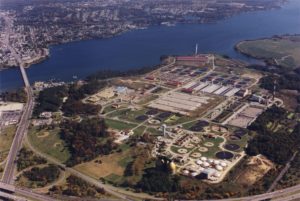
This facility is situated on the west shore of the Back River, just beyond the Inner Harbor, and is a tributary of the Chesapeake Bay. Sited on 466 ac., I’m fascinated to learn that there’s a 35-ft. elevation difference “from influent to outfall”. That has the effect of allowing wastewater to flow through the plant entirely by gravity.
According to construction-today.com: “An estimated 1.3 million residents in a 140-square-mile area of Baltimore city and county are served by this plant.”
The same Post article also reported: “Measures of dissolved oxygen in the harbor also improved, contributing to a decrease in the large fish kills that occur when algae blooms die and create dead zones devoid of oxygen.
Another in the plus column of it, National Aquarium volunteers recently counted 130 species of fish, crustaceans, birds and insects alive in the Inner Harbor.
Fly fishing is reportedly occurring in the Jones Falls, which runs 17.9 mi. from Lake Roland south to the Inner Harbor, while “massive sewer overflows of millions and millions of gallons” discharge into the Jones Falls, also causing sewer backups in nearby homes.” (???)
